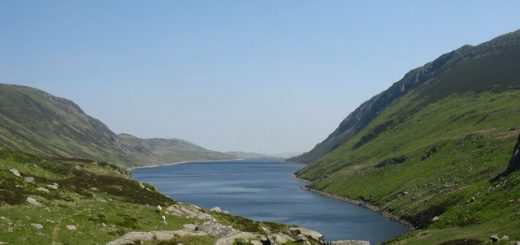Gypsy Race
The Gypsy runs from the Great Wold Valley and out into the North Sea at Bridlington. Bad fortune is said follow when the Gypsey Race flows. The following description of the Gypsey Race was published as response to a letter in the Bridlington Free Press on Wednesday 21 May 2008.
The water rises at Wharram and after copious rainfall it runs on the surface, just above the Kimmeridge Clay at the base of the Wold Chalk line, then goes underground until the Clay can no longer contain it and out it springs forming a sudden Gypsey.This spring then runs as a fast flowing ‘Race’ but then can disappear underground for a few years and then the stream bed is dry.
The comings and goings of the stream are forever fixed in our local folklore as either good or bad luck. The ‘Woe Waters’ when the stream was in flood foretold disasters for the country.
It ran as a flood before the Black Death, before the Civil War, at the execution of Charles the First, in 1861 the year of the bad harvest, the two World Wars and also the bad winters of 1947 and 1962.
![Darren Haddock [CC BY-SA 2.0 (https://creativecommons.org/licenses/by-sa/2.0)]](http://www.mysteriousbritain.co.uk/wp/wp-content/uploads/2018/11/Gypsey_Race_-_geograph.org_.uk_-_278487-225x300.jpg) But in 1530 it was lucky for Prior Willy from Bridlington when he was chased by wicked fairy types at Willy Howe because he managed to jump his horse over the stream and escape his pursuers (fairy folk can’t cross over fast-flowing water!)
But in 1530 it was lucky for Prior Willy from Bridlington when he was chased by wicked fairy types at Willy Howe because he managed to jump his horse over the stream and escape his pursuers (fairy folk can’t cross over fast-flowing water!)
The stream also gave a good fortune to Queen Henrietta Maria when she sheltered in its banks at Beck Hill from cannon balls whilst in Bridlington in 1632.
The children of Burton Fleming used to ‘Race’ the stream when it burst forth and ran again through the village after a dry period and floated sticks on its surface. But on February 19 1827 we find “William, the 11-year-old son of Will and Faith Major, drowned whilst racing the Gypsey, but his three friends who also fell in were all saved, as in the scriptures”.

![Darren Haddock [CC BY-SA 2.0 (https://creativecommons.org/licenses/by-sa/2.0)]](http://www.mysteriousbritain.co.uk/wp/wp-content/uploads/2018/11/Gypsey_Race_Burton_Fleming-300x225.jpg)



Re: Gypsy Race
The Gipsies are pretty well known as streams of water which at different periods are observed on some parts of the Yorkshire Wolds. They appear toward the latter end of winter or early in the spring; sometimes breaking out very suddenly, and, after running a few miles again, disappearing. That which is more particularly distinguished by the name of The Gipsy has its origin near the Wold-cottage at a distance of about twelve miles W.N.W. from Bridlington. The water here does not rise in a body in one particular spot, but may be seen oozing and trickling among the grass, over a surface of considerable extent, and where the ground is not interrupted by the least apparent breakage; collecting into a mass, it passes off in a channel, of about four feet in depth and eight or ten in width, along a fertile valley towards the sea, which it enters through the harbour at Bridlington. . . . There is sometimes an intermission of three or four years. . . . A custom formerly prevalent among the young people at North Burton, but now discontinued . . . was "going to meet the Gipsy" on her first approach. — T. C, Bridhngton.
The Table Book, by William Hone. London : 1827, pp. 115, 116.
Re: Gypsy Race
COUNTY FOLK-LORE VOL. VI. PRINTED EXTRACTS No. VIII. EXAMPLES OF PRINTED FOLK-LORE CONCERNING THE EAST RIDING OF YORKSHIRE COLLECTED AND EDITED BY Mrs. GUTCH (1911)
A Mysterious East Riding Stream. Woe-Waters of the Wold. A correspondent of the London "Daily Mail " gives some particulars of a mysterious East Riding stream which comes and goes like a will-o’-the-wisp and the appearance of which superstitious folk regard as the harbinger of evil, and which is just now almost the sole topic of conversation in the villages and hamlets among the wolds and dales of North-East Yorkshire.
To solve the mystery of the "Gypsey Race," as the strange waters are called, has been the ambition of many modern scientists. Little, however, has yet been discovered to account for its eccentricities. Almost as suddenly as they came, some six weeks ago, the waters will shortly disappear, and may not be seen again for years. Only five or six times during the last twenty-one years has this brook run its eerie course. Its source of origin is a hidden mystery. The strange workings of Nature, however, appeal to the curiosity and imagination of the Yorkshire wold-dweller.
Day by day young and old watch the stream running its twenty-mile course of hide and seek among the chalk to the sea at Bridlington. Astonishment is often mingled with awe, for according to tradition dire disasters follow in the wake of the brook, and which in consequence bears the sinister title of " The waters of woe." Superstitions die hard, and in these out-of-the-way wolds people are still to be found whom it is difficult to dissuade that the running of a stream fed by an intermittent spring is not in some way associated with the supernatural. I have tried hard, however, to find someone who can give personal testimony in support of the theory that the appearance of the mysterious waters is a prognostication of trouble. With the exception of some heavy floods in the winter of i860 and a great storm at sea in 1880, no one can remember that the coming of the stream has been attended by any particular local woe. The legend seems to be founded on incidents belonging to a very distant past.
The "gipsey," it is said, appeared just before the great plague, before the restoration of Charles IL, and a few weeks prior to the landing of the Prince of Orange. Its appearance in 1795 is also reported to have synchronised with the descent of a huge meteorite in the village of Wold Newton.
The mysterious stream meanders through this quaint little village, some of the inhabitants of which have not yet ceased to talk of the " bolt from the sky " and its supposed affinity with the " woe- waters " of the wold. Originating from an intermittent spring which bursts through the chalk strata to the east of the village of Wharram-le-street the gipsey stream performs at times so many queer pranks that its vagaries may have given rise to some of the superstitions associated with its appearance.
For instance, the waters may be running strangely at one end of a field and at the other end of the bed of the stream be quite dry. On one occasion the stream literally passed through some cottages at Kirby Grindalythe, the water forcing its way through the ground floors and only being released by artificial means. At times trout have been seen in the mystic brook.
Some authorities declare that the stream derives its origin from the Greek word Gupos (chalk), while others aver that it means the same as the ordinary gipsey wanderer. Only once during the last fourteen years have the limpid waters of this strange rivulet run as strongly as they have during the last few days. There are already indications, however, that the waters are about to ebb. Soon the stream will have entirely disappeared and children will again play in its dry and erstwhile channel. The waters, however, will not be forgotten, and not a few old folk will quietly, but anxiously, wait to see whether the gipsy’s warning of 1910 of " battle, plague, and famine " come true or not. — Y.H. April 5th, 1910.
Re: Gypsy Race
The Gipsies.
My Prophetick Spring at Veipsey, I may show,
That some years is dry’d up, some years again doth flow;
But when it breaketh out with an immoderate birth
It tells the following year of a penurious dearth.
The Complete Works of Michael Drayton now first collected with Introductions and Notes by the Rev. Richard. Song 28.